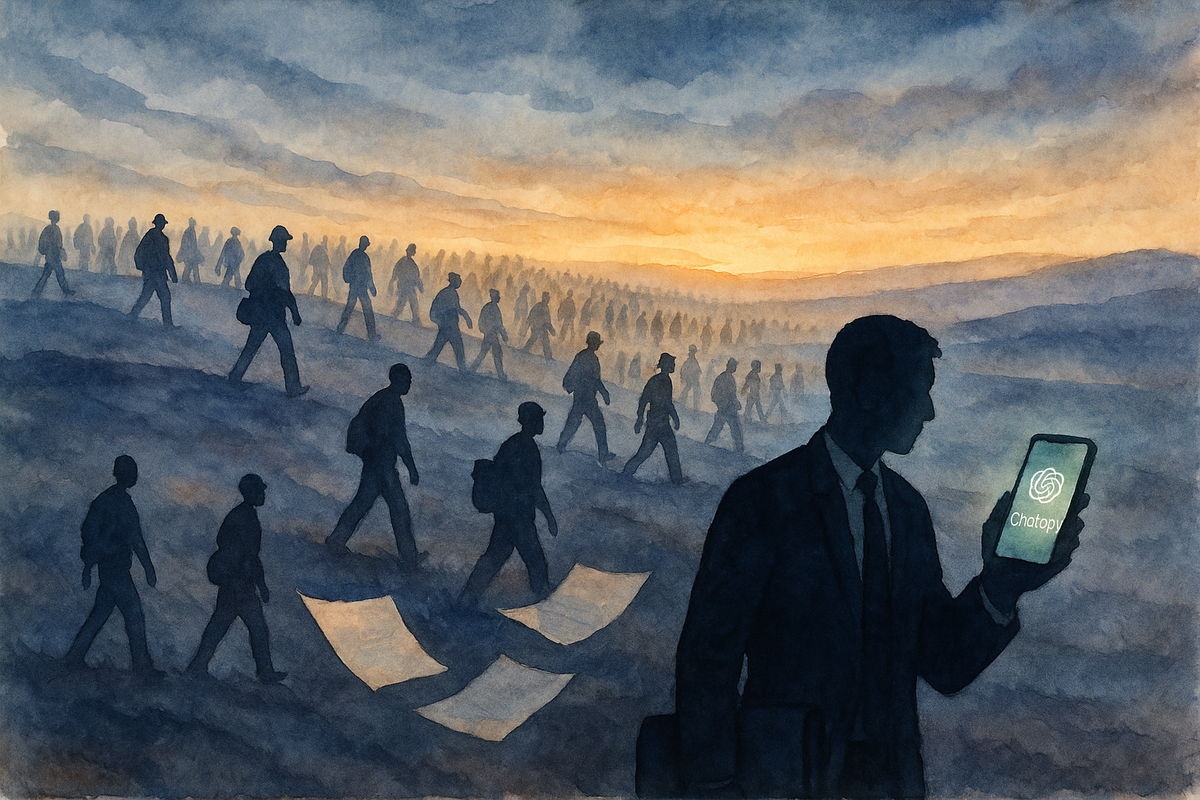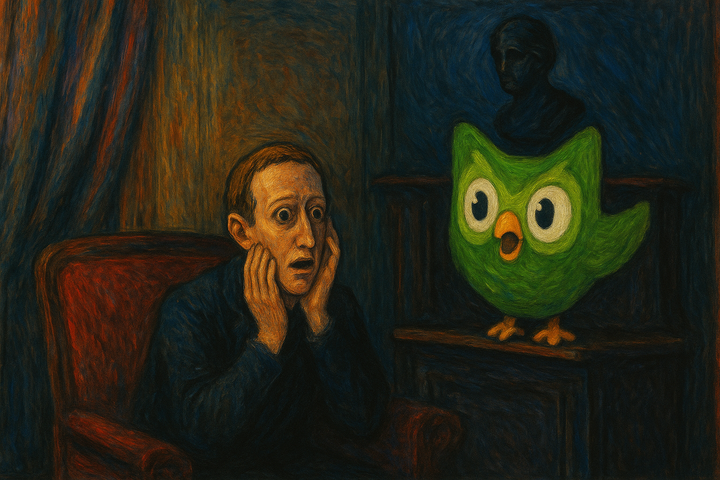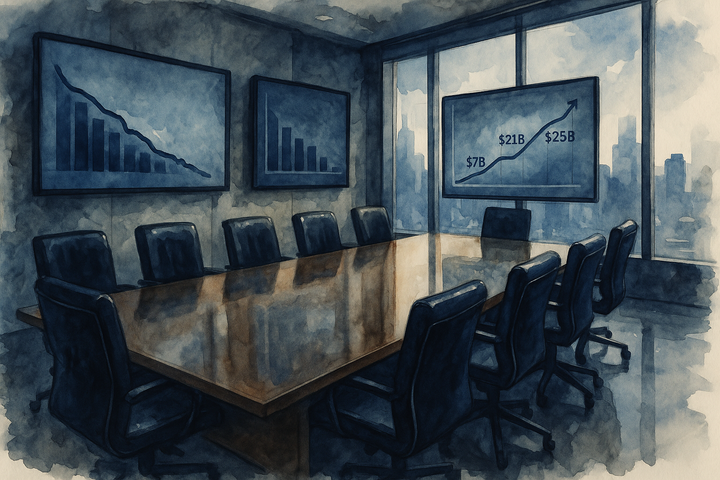The Hidden Human Cost of AI-First Transformation: Why 38% of Workers Fear for Their Jobs (And What That Means for Your Business)
"Just put it in ChatGPT." Those seven words marked the end of her dream job. Now 800 million workers worldwide face the same threat—and their anxiety predicts business failure.

The stories behind the statistics reveal why human-first AI adoption isn't just more ethical—it's more profitable.
Just a quick word before we go into the article. The night before this was published, we hit our 100th newsletter subscriber. Hey, I know, not a huge number. But this newsletter only started a couple of weeks ago, so that's some pretty impressive growth in such a short time.
If you're finding this newsletter useful and informative, please share it with someone that might agree. Thanks! Now onto the story...
-Magnus
When Seven Words Changed Everything
"One day, I overheard my boss saying: just put it in ChatGPT."
For a garden center copywriter, those seven words marked the beginning of the end. After investing a month's wages in training and eight months building expertise in her dream job, she was terminated just before Christmas. Her manager had assured her the job was safe just six weeks earlier.
Today, the company's website reads like a manual: sterile, factual, devoid of the passion for gardening that once drew customers in. The human touch that made people want to plant something beautiful has been automated away.
This moment—executive enthusiasm for AI efficiency colliding with worker vulnerability—is playing out across industries. Research from the American Psychological Association reveals that 38% of US workers now worry AI will make their jobs obsolete, with 51% of those workers reporting this anxiety negatively impacts their mental health.
But here's what most business leaders miss: this psychological crisis isn't separate from business outcomes—it predicts them. The same mindset that dismisses worker concerns is driving the 80% failure rate documented in AI projects and creating the conditions I've been tracking since my analysis of Duolingo's AI-first disaster.
I'm flattered to see you're enjoying our newsletter. Just give us credit when you borrow heavily from our free newsletter for your own paid substack. Our readers have let us know.
The Scale of What's Coming
The "just put it in ChatGPT" mentality isn't just creating individual tragedies—it's setting up potentially the largest economic displacement in human history.
McKinsey projects that between 400 and 800 million jobs could be displaced globally by 2030, with up to 375 million workers—representing 14% of the global workforce—forced to change occupations entirely. To grasp this scale: 800 million people represents more than the combined populations of the United States, the entire European Union, and Japan.
Yet we're experiencing what researchers call the "gradually then suddenly" pattern. Current tracking shows fewer than 17,000 US jobs were lost directly to AI between May 2023 and September 2024—a deceptively modest number that masks exponential acceleration ahead.
Recent reporting from The Guardian reveals the human faces behind this coming disruption: journalists replaced by AI avatars that "interview" dead poets, artists whose work trains the systems displacing them, voice actors whose signatures are stolen without consent. These aren't isolated incidents—they're early indicators of systematic replacement strategies that treat human expertise as interchangeable with automation.
The Psychology of Business Failure
What makes this pattern particularly dangerous is how worker anxiety directly translates into operational failure. Research published in Nature demonstrates that AI adoption significantly increases job stress, which drives employee burnout and reduced performance. When the garden center executive chose ChatGPT over human expertise, the company didn't just lose a writer—they lost someone who understood customers' emotional connections to gardening.
The RAND Corporation's analysis of 65 experienced data scientists and engineers identified leadership disconnection as the primary cause of AI project failure. Business leaders who view AI as wholesale replacement systematically underestimate both human expertise complexity and the psychological conditions needed for successful technology adoption.
The Executive Enthusiasm Gap: While executives get excited about efficiency gains, they rarely calculate the psychological costs. Studies show direct correlation between AI displacement fears and decreased innovation. Workers afraid of replacement stop contributing insights that make AI implementations successful.
The Trust Collapse: Organizations implementing AI without considering human impact destroy the collaboration needed for technology success. The garden center's remaining employees watched their colleague's expertise get dismissed as easily replaceable—a message that inevitably affects their own engagement and performance.
This explains why we're seeing the emergence of what I've termed the 55% regret club—organizations that rushed to replace human capabilities and are now desperately trying to rebuild what they destroyed.
The Hidden Multiplier Costs
The true expense of AI-first transformation extends far beyond immediate displacement. Organizations are discovering that dismissing human expertise creates cascading problems that multiply costs exponentially.
Knowledge Destruction: When Radio Kraków replaced experienced journalists with AI avatars, they lost editorial judgment needed to avoid disasters like "interviewing" deceased poets. The public outrage was immediate—tens of thousands signed petitions demanding the station scrap its AI experiment.
Cultural Competence Loss: Voice actors finding their signatures stolen highlight how AI-first approaches often overlook diversity and cultural authenticity. One American-Samoan voice actor noted that AI-generated cultural voices risk being "inaccurate and even offensive—just a bunch of numbers imitating a culture."
Customer Experience Degradation: The garden center's website now teaches plant facts but fails to inspire gardening—a fundamental failure for a business whose success depends on emotional engagement. Companies discover too late that audiences distinguish between authentic human connection and AI-generated content.
Innovation Drain: Research demonstrates that psychological safety is crucial for innovation. When employees feel replaceable, they stop contributing creative insights that drive competitive advantage. Organizations gain task automation but lose human innovation capacity.

The Manufacturing Preview
Manufacturing offers a preview of what's coming across all sectors. MIT and Boston University research indicates that 2 million manufacturing jobs will be displaced by 2025, with each robot replacing approximately 1.6 workers. But the pattern reveals something more troubling: displaced manufacturing workers typically move to service industries equally vulnerable to automation—transportation, maintenance, construction.
This creates what economists call "automation cascades"—waves of displacement that ripple through interconnected economic sectors. Communities built around manufacturing face not just individual job losses but systematic economic collapse as entire skill ecosystems become obsolete.
The Human-First Alternative
While competitors stumble through AI-first strategies, organizations that understand human-AI collaboration are building sustainable advantages. The research validates what I've been advocating: treating AI as enhancement rather than replacement creates both better psychological outcomes and superior business results.
Microsoft's Frontier Model: Companies mastering human-AI collaboration outperform automation-focused competitors. Successful organizations develop optimal human-agent ratios for different functions—understanding where human judgment adds irreplaceable value.
Psychological Safety as Strategy: Organizations maintaining psychological safety during AI adoption see better outcomes across multiple metrics. When employees feel valued and involved rather than threatened, they contribute insights that improve AI performance and identify problems before they become costly failures.
Training Investment Returns: Research shows that workers with higher AI learning confidence experience significantly less stress and better outcomes. Organizations investing in comprehensive AI partnership training see both improved mental health and superior business results.
The contrast is stark: while AI-first companies join the regret club, human-first organizations capture both productivity gains and innovation advantages.

What This Means for Leaders
Every executive now faces a choice that will define their organization's future: embrace the "just put it in ChatGPT" mentality that creates worker anxiety and project failure, or build competitive advantage through strategic human-AI collaboration.
The 38% of workers who fear AI displacement aren't just worried—they're sending signals about psychological conditions that predict business outcomes. When employees fear replacement, they create the exact conditions that lead to the 80% AI project failure rate documented by RAND Corporation.
Critical Assessment Questions:
- When you hear executives suggesting to "just put it in ChatGPT," do you recognize the warning signs of business failure?
- Are your AI initiatives focused on replacing human capabilities or enhancing them?
- Have you invested in AI partnership training that builds employee confidence rather than anxiety?
- Are you measuring psychological safety alongside technical metrics?
The Competitive Window: As I predicted in my analysis of Duolingo's failure, organizations that master human-AI collaboration while competitors fumble replacement strategies will capture lasting advantages. This window is narrowing as more leaders recognize the pattern.
The Talent Opportunity: As competitors eliminate experienced workforce through automation mistakes, skilled professionals become available. Smart organizations are recruiting the human expertise that AI-first companies are foolishly discarding.
Building Human-Centered AI Organizations
The path forward requires recognizing that successful AI transformation depends on human psychology as much as technology capability. Organizations can harness AI's power without creating the psychological crisis that predicts business failure.
Start with Impact Assessment: Before implementing AI, understand how changes affect workforce psychology. The 38% who fear displacement are warning you about conditions that determine project success or failure.
Design for Partnership: Instead of asking "What can AI replace?" ask "How can AI make our people more powerful?" This reframing leads to solutions that preserve expertise while scaling capability.
Measure Human Metrics: Track psychological safety, employee confidence, and engagement alongside technical performance. Organizations mastering both human and technical aspects consistently outperform automation-focused competitors.
Invest in Partnership Skills: Comprehensive training that builds AI collaboration confidence creates the foundation for successful implementation. Workers who understand how to work with AI become advocates rather than obstacles.
The Choice Ahead
The evidence is overwhelming. The patterns are documented. The frameworks exist.
When executives say "just put it in ChatGPT," they reveal the mindset that creates both human suffering and business failure. The 38% of workers who fear AI displacement aren't just anxious—they're predicting the psychological conditions that drive the 80% project failure rate.
Organizations have a choice: learn from the garden center that lost its soul to automation, or build the human-AI partnerships that create sustainable competitive advantage. The companies that choose wisely will dominate industries while competitors rebuild capabilities they carelessly eliminated.
This transformation isn't simple, and you don't have to navigate it alone. The patterns are clear, the successful approaches are validated, and the competitive advantage awaits leaders brave enough to choose partnership over replacement.
Take Action Today: Subscribe to my newsletter for insights that could transform your AI strategy. Share this analysis with leaders wrestling with similar challenges—your perspective could help others avoid the predictable pitfalls of AI-first thinking. Consider sharing with your LinkedIn network, where your insights could help executives understand the human stakes in their technology decisions.
For organizations ready to implement AI strategically, Groktopus specializes in helping leaders build human-centered AI approaches that enhance rather than replace human expertise. We've helped companies avoid the regret club by designing optimal human-AI collaboration frameworks. Contact us to explore how we can help your organization capture AI's advantages without sacrificing the human capabilities that drive long-term success.




Comments ()